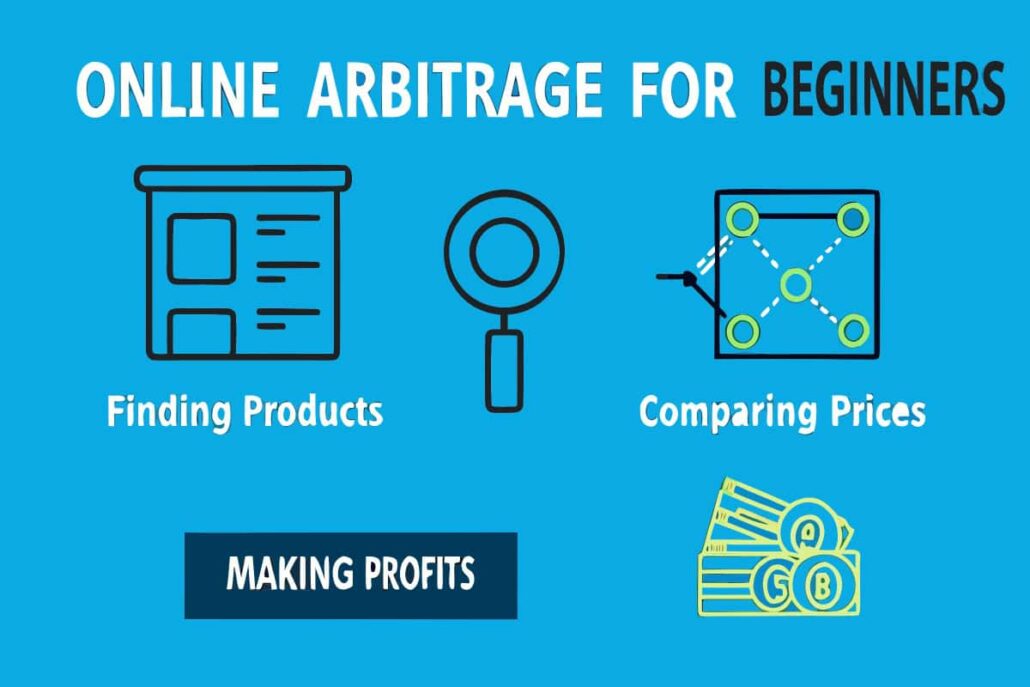
Online arbitrage is quickly becoming one of the easiest ways for new sellers to start an online store. Rather than driving from aisle to aisle to spot discounted clearance items, shoppers now scan deals from across the web in their pajamas and restock their digital shelves from the sofa.
Online Arbitrage for Beginners
For anyone thinking about turning simple product-scouting into a side job or even a full-time gig, this beginner-friendly guide sums up the basics, the tools you need, proven strategies, and the speed bumps to dodge on the path to profit.
Understanding Online Arbitrage
In plain terms, online arbitrage means snatching up an item from one website and flipping it on a second site at a higher price. The profit comes from the gap between what you pay and your selling price, plus any hidden market quirks only a sharp eye can spot.
Pricing for the same product can swing wildly from one corner of the web to another. What sits at $20 on a clearance page may list for $35 on Amazon. Your job is to hunt those spreads, snatch the low-priced stock, and let the market do the rest.
How Online Arbitrage Differs from Other Business Models
Private-labeling and wholesale lock you into big orders and even bigger budgets, but online arbitrage lets you jump in with just a hundred bucks and build step by step.
Many people think dropshipping and online arbitrage are twins, yet arbitage means buying, scanning, and actually holding the item. Because of that, you guide packing and shipping yourself and keep a clearer picture of every customers experience.
Getting Started with Online Arbitrage
Choose Your Selling Platform
Newbies almost always pick Amazon FBA-Fulfillment by Amazon-because its team handles storage, shipping, and even angry customer emails for them. Still, eBay, Facebook Marketplace, and personal mini-webs welcome arbitage deals too.
Just keep in mind that certain Amazon categories need a thumbs-up first, so dig into the rules before you snag any hot product. Toys, home goods, and little electronics extras usually stay on the green-light list for new sellers.
Essential Tools and Software
Smart online arbitragers lean on handy apps to sift through numbers, watch price swings, and keep shelves-full of stock in plain view.
Product Research Tools
- Keepa or CamelCamelCamel show Amazon pricing history, so you know how a product’s cost has changed over time.
- FBAScan and Profit Bandit let you scan barcodes on the spot and see if each item is worth buying.
- Tactical Arbitrage runs batches online, hunting for deals while you handle other tasks.
Price Monitoring Software
- Honey and InvisibleHand pop up discount codes at checkout, so you never miss a coupon.
- Google Shopping quickly compares prices across stores, saving you time and money.
- Store apps from Walmart, Target, and others often run secret flash sales, so check them regularly.
Inventory Management
- InventoryLab and RestockPro record every buy and show how much profit you really make.
- A simple Google Sheets or Excel workbook works fine for anyone just getting started.
- Keep receipts tidy with apps like Shoeboxed, so you have proof if a question comes up.
Finding Profitable Products
Research Strategies
Look for items that sell steadily and dont jump in price. Target products priced between $15 and $50; they often carry solid margins but are less risky than high-end gear.
Seek objects that move 10 to 20 times a month. Faster-selling stock frees up cash quickly, even if it means more rivals.
Calculating Profitability
Before you buy, run this quick profit check:
Net Profit = Selling Price – Purchase Price – Fees – Shipping – Storage.
On FBA, fees eat up 8 to 15 percent of the sale, plus monthly storage charges. Also, set aside 5 to 10 percent for returns, which vary by category.
A solid profit goal is to look for products that bring in at least 30 percent after all costs are paid. That cushion gives you room if prices drop or extra fees pop up.
Seasonal Considerations
Knowing when a product is in demand lets you buy at the right time and keeps you from sitting on slow stock. For example, toys usually peak in the fourth quarter, while outdoor gear shines in spring and summer.
Google Trends is an easy way to spot those seasons and lay out your inventory plan. Lots of sellers also list seasonal goods two to three months ahead of the rush.
Common Sourcing Strategies
Retail Website Clearance Sales
Big chain stores like Walmart, Target, and Best Buy clear old stock with deep markdowns almost every week. Join their email lists and glance at the clearance tabs daily.
End-of-season events really shine here. Winter jackets in February or swimming pools in August often get slashed even more.
Flash Sale Websites
Websites such as Woot, Overstock, and Zulily run quick pop-up sales on all kinds of items. Those short windows create pricing gaps that resellers can quickly tap into.
Set alerts for the categories you track and jump on deals fast. Hot offers on these sites can sell out in just a few hours.
Manufacturer Direct Sales
Some brands cut out the middleman and sell straight to shoppers on their own sites, often at wholesale prices. Finding these deals takes a little digging, but the bigger profits are worth the effort.
Always check if a company throws in free shipping or gives price breaks on bulk buys. Even if you can’t hit their minimum order today, save the link for when your sales grow.
Managing Your Online Arbitrage Business
Inventory Organization
Write down every purchase, noting the product name, price paid, hoped-for selling price, and planned profit. This simple log shows which sourcing tricks really work.
For items stored at home, group them by ASIN or SKU and stick on big, readable labels so nothing gets lost when it’s time to ship.
Scaling Your Operations
When orders pick up, think about ways to grow faster:
- Automate Research: Grab a tool that scans thousands of products for deals while you sleep.
- Hire VAs: Let virtual assistants track listings and write descriptions so you can plan bigger moves.
- Diversify Platforms: List extras on eBay, Facebook Marketplace, and even your own site to reach new shoppers.
- Increase Capital: Reinvest part of each month’s profit to buy more stock and snatch up larger, better deals.
Tough Times and Simple Fixes
Price Wars and Unending Rivalry
Once a product looks hot, countless sellers jump in, and everyone starts slashing prices. That kind of race can squeeze your profit so hard it barely covers shipping. To stay clear of the mess, steer away from ASINs packed with rivals unless your costs are way lower.
Instead, hunt for listings where 3 to 5 sellers play ball and prices rarely wobble. These quieter items tend to pay out steadier than the loud bestsellers everyone chases.
The Fear of Account Shutdown
Every major platform comes with a thick rule book about what counts as real stock, what condition it must be in, and how friendly your service is. Buy only from certified distributors, snap receipts, and stash those records where you can grab them fast.
Keep your seller numbers glowing by describing items with clear honesty, shipping as soon as you can, and answering buyer questions in a heartbeat.
Cash Upfront Always Hurts
Jumping into online arbitrage means fronting cash for each box, and that money sits there until the last pair of socks is sold. If that thought makes you twitch, start with a small load and feed your next purchase from what the first batch earns.
You might also look at 0% intro-rate business cards to stretch your budget, but tread lightly and sketch a plan to pay it all back before the interest kicks in.
Tax Time and the Law Watch You
No one wants a surprise letter from the tax office, so act like a real business right from the start. Pick the right setup-LLC, sole prop, or whatever fits-and grab the licenses your city or state demands.
An hour with an attorney or friendly accountant can save you headaches later, so schedule that chat and make sure your paperwork marches in step with local laws.
Sales Tax Obligations
If you sell online, you usually have to collect sales tax in states where you have nexus. Nexus can mean a physical store, an employee, or simply a large volume of sales. With Fulfillment by Amazon (FBA), the companys warehouses in various states create that connection for you.
To keep things simple, consider using platforms like TaxJar or Avalara. These tools automatically track orders, calculate the right rates, and help you file on time.
Record Keeping
Keep a clear, detailed record of every dime your business spends. Track product buys, shipping fees, Amazon charges, and any other costs. This data is vital not just for taxes, but also for figuring out which products really earn you money.
Store paper receipts in a dedicated drawer, but also scan and upload them to the cloud. Aim to hold records for at least three years so you stay ready for any audit.
Building Long-term Success
Developing Expertise
Winning online arbitrage sellers know their chosen niches inside and out. That knowledge lets them spot hidden deals other people overlook and decide quickly when to buy.
Pick two or three categories to master at first. Track seasonal spikes, hot brands, and common problems so you can talk confidently about each group.
Building Relationships
Friendly ties with customer service teams at big stores can pay off. Representatives often hint about upcoming sales, clearance events, or restocks before the general public knows.
You should also jump into online forums and social media groups for arbitrage sellers. Sharing wins, losses, and fresh strategies with peers expands your network and teaches new ways to earn.
Continuous Learning
The online-arbitrage world never sits still, and newcomers feel the change in every month. Policy tweaks, fresh sellers, and sudden price shifts can flip a once-stable product upside down. To keep pace, carve out time each week for at least one industry blog, quick podcast episode, or mini training course—little bites that build big knowledge.
When a new idea tempts you, test it small first: five items, one store, a single week. Large dollars rarely fix a problem they can even create, and every market is unique.
Taking Your First Steps
Online arbitrage greets nearly anyone who browses fast from the couch. The road is open, but patience, clear numbers, and learning from wins and losses steer the journey.
Launch with a small budget, own the basics, and let data, not hunches, guide your next step.
Remember that growth, repeat orders, and steady profit demand time and steady effort. Cultivate skills, document your moves, and build systems that scale when you do.
Treat online arbitrage like a real business, not a midnight money-making promise. With planning, the right tools, and careful follow-through, you can grow an income that pays bills and sharpens real-world experience.

